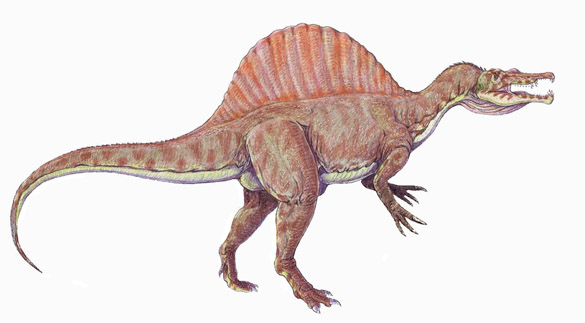 The fossil above is the best of a collection of dinosaur teeth given to us by the generous George Chambers (’79). The species that held it is the gargantuan theropod predator Spinosaurus aegyptiacus Stromer, 1915. The teeth are from Cenomanian (Upper Cretaceous) rocks exposed near Alnif, Morocco.
The fossil above is the best of a collection of dinosaur teeth given to us by the generous George Chambers (’79). The species that held it is the gargantuan theropod predator Spinosaurus aegyptiacus Stromer, 1915. The teeth are from Cenomanian (Upper Cretaceous) rocks exposed near Alnif, Morocco.
 Here are some more of our Spinosaurus aegyptiacus tooth collection. You can see that the teeth have been extensively repaired with plaster and epoxy. That’s fine for us because they’re the only dinosaur teeth we have!
Here are some more of our Spinosaurus aegyptiacus tooth collection. You can see that the teeth have been extensively repaired with plaster and epoxy. That’s fine for us because they’re the only dinosaur teeth we have!
Spinosaurus is surprisingly little known in the general public, at least until the Discovery Channel started making incredible videos about the extinct beast. It was the largest of all carnivorous dinosaurs yet discovered — even bigger than Tyrannosaurus, Allosaurus and Gigantosaurus. Some specimens were up to 18 meters long. Spinosaurus was characterized by long spines extending up from the vertebrae almost like a pelycosaur. Its head was like that of a crocodile — long and narrow. Its teeth, too, are like those of crocodiles and alligators, being blunt, rounded and strong rather than sleek and sharp. They probably crushed and shook their prey in a crocodilian way as shown in those amazing Discovery Channel videos.
The original specimen of Spinosaurus was discovered in Egypt in 1912. Those fossils were completely destroyed when Munich, Germany, was bombed in 1944 by the Royal Air Force. Since then a few other incomplete skeletons have been found, along with lots of teeth.
 Spinosaurus was found, described and named by Ernst Freiherr Stromer von Reichenbach (1870-1952), a German paleontologist and aristocrat. Stromer’s scientific odyssey is worthy of a movie and is the basis of an excellent book (The Lost Dinosaurs of Egypt). He began his paleontological work in Egypt in 1910 at a time tensions between the British and Germans were ramping up. He fought disease, weather extremes and bureaucratic delays to make his unexpected dinosaur discoveries. As just one example, his fossils actually arrived in Germany in 1922 — ten years after they were collected. (World War I only took up four of those years.) In his latter years he refused to join the Nazi Party and maintained relationships with Jewish friends. This may have led to the destruction of the Spinosaurus specimens because the Nazi director of the Munich museum refused to move the fossils to a safe location. In the end he outlived the Kaiser and the Führer, dying at the age of 82 in 1950. A tough paleontologist in a tough time.
Spinosaurus was found, described and named by Ernst Freiherr Stromer von Reichenbach (1870-1952), a German paleontologist and aristocrat. Stromer’s scientific odyssey is worthy of a movie and is the basis of an excellent book (The Lost Dinosaurs of Egypt). He began his paleontological work in Egypt in 1910 at a time tensions between the British and Germans were ramping up. He fought disease, weather extremes and bureaucratic delays to make his unexpected dinosaur discoveries. As just one example, his fossils actually arrived in Germany in 1922 — ten years after they were collected. (World War I only took up four of those years.) In his latter years he refused to join the Nazi Party and maintained relationships with Jewish friends. This may have led to the destruction of the Spinosaurus specimens because the Nazi director of the Munich museum refused to move the fossils to a safe location. In the end he outlived the Kaiser and the Führer, dying at the age of 82 in 1950. A tough paleontologist in a tough time.
References:
Amiot, R., Buffetaut, E., Lécuyer, C., Wang, X., Boudad, L., Ding, Z., … and Zhou, Z. 2010. Oxygen isotope evidence for semi-aquatic habits among spinosaurid theropods. Geology 38: 139-142.
Buffetaut, E. and Ouaja, M. 2002. A new specimen of Spinosaurus (Dinosauria, Theropoda) from the Lower Cretaceous of Tunisia, with remarks on the evolutionary history of the Spinosauridae. Bulletin de la Société géologique de France 173: 415-421.
Nothdurft, W. and Smith, J. 2002. The Lost Dinosaurs of Egypt. Random House, 242 pages.
Smith, J.B., Lamanna, M.C., Mayr, H. and Lacovara, K.J. 2006. New information regarding the holotype of Spinosaurus aegyptiacus Stromer, 1915. Journal of Paleontology 80: 400-406.



